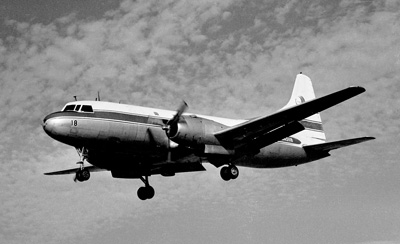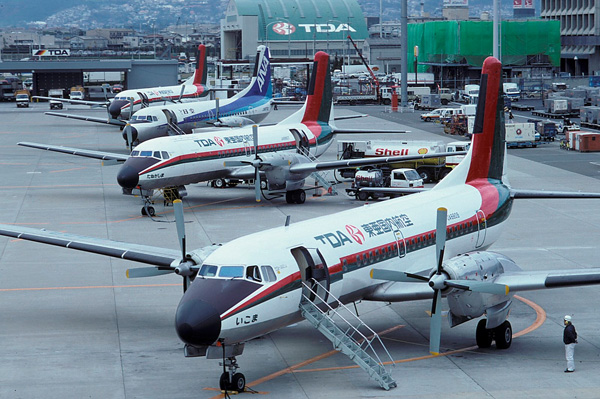The beginning
In the summer of 1952, on July 4, Nitto
Aviation (Nittoh Koku)
was founded, a company that has been active in the southern half of
Japan. For instance, Nitto Aviation ran a scheduled service by Grumman
Widgeon or Mallard between Osaka and Beppu, on the northeastern coast
of the southern island of Kyushu. We also know that Nitto operated the
DHC-3 Otter because one of those, JA3115 (223),
crashed between Osaka and Shikoku Island.
A few months after Nitto, on
September 13, 1952, Fuji Airlines (Fuji
Koku) saw the light and its fleet contained the DH-114 Heron
and Convair 240. One of each can be identified again due to mishaps:
DH-114 JA6159 (14026) and Convair
240 JA5098 (53). As indicated by the name
this company was concentrating its activities in central Japan.
The next
summer, on June 30, 1953, NJA - North Japan Airlines (Kita
Nihon Koku) made a start, this name being used again nowadays
by the operator of a few Ce172s and a PA-34. This company too operated
a number of Convair 240s during the fifties and at some moment served
a network from its base in Sapporo that contained Kushiro, Hakodate
(all three on Hokkaido Island) and Akita (in the northeast of the principle
island of Honshu).
 |
|---|
| Toa Airways Convair 240 JA5118 on short final for Osaka-Itami on 15 May 1968, wearing the standard outfit for Japanese airlines in those days. (Ryohei Tsugami) |
On April 15, 1964 these three firms joined together to form JDA - Japan Domestic Airlines (Nihon Kokunai Koku), resulting in a true national route structure. This was probably not a big issue on the part of colour schemes as most Japanese companies, including All Nippon and Japan Air Lines, had similar liveries on their aircraft at that time. These uniform looks comprised a grey lower half and a white upper half for the fuselage, a blue band at window-height and a red logo. The name was written in Japanese above the windows, it would be long before western writing appeared on the planes.
A few Convair 240s in the JDA fleet were JA5087 (17, form the inventory of Kita Nihon Koku), JA5092 (47, now in the Planes of Fame Museum at Chino, CA), and JA5120 (177). A Heron that has has well enjoyed its pension is JA6159 (14027). This airplane left active service with JDA in 1969 and was on display in excellent condition in a Fukuoka playground during the nineteen-nineties. On March 11, 1965 JDA became the first commercial operator of Japan's pride in civil aviation: the NAMC YS-11, a type that will get extensive attention further on in this article. JDA also used the Nord 262 and of this small turboprop construction number 2 has been in service as F-BLHQ. The airplane later crashed into the Mediterranean Sea off Algiers, on New Year's Eve 1971. Three others that we know of are JA8646 (8, parted out at Dinard, France until 1995), JA8652 (15, used for spares at La Ceiba, Honduras in 2000) and JA8663 (22, parked at Trieste, Italy with expired certificate of airworthyness by the end of 1986).
Nihon Kokunai Koku entered the jet age on January 4, 1965 with a very impressive aircraft type, the Convair 880. JAL already had a number of these in service but for JDA things took a dramatic turn: JA8030 (45), a former Swissair machine, crashed during take-off from Tokyo-Haneda on August 26, 1966. Luckily no passengers were aboard but the crew of five perished in the accident. However, let there not be an impression of bad fortune in Japanese civil aviation in those days, there was a lot of air traffic already over this densely populated and mountainous country and comparitively little went wrong. Anyhow, the only other jet airliner used by JDA was the B727 and again this was for a short period of time: JA8314 (19138) and JA8315 (19139) were leased from Japan Air Lines by the end of March and in the middle of April 1966 respectively, and returned already on the first day of June.
Five months after North Japan Airlines, on November 30, 1953, TAW - Toa Airways (Toa Koku) was formed. As illustrated by old timetables this grew into a considerably large airline with destinations all over the western half of Japan by 1970, from Nagoya to the Goto Islands west of Kyushu. TAW too was a Heron and Convair 240 operator and launch customer of the YS-11, about a month after Japan Domestic Airlines. DH-114 JA6158 (14028, this number following the two mentioned before) flew into Mt. Ohira in 1962 and JA5131 was a Convair 240 (96) that has been on display in Tokyo and Hiroshima after 1968, and was broken up in 1989. Another Convairliner of Toa Airways was JA5118. Apart from the types mentioned already, the companies reviewed here also used the DC-3 (until 1964), Beech 18 (from '57 till '69), DH-104 Dove ('59 - '68) and some smaller Pipers and Beeches.
